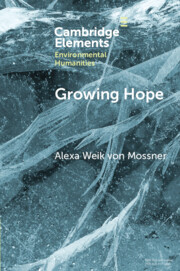Refine search
Actions for selected content:
216 results
15 - Grace
- from Part II - Theological Themes
-
-
- Book:
- The Origins of Scholasticism
- Published online:
- 18 November 2025
- Print publication:
- 08 January 2026, pp 413-436
-
- Chapter
- Export citation
Chapter 6 - Tragedy and Death in the Phaedo
-
- Book:
- Plato on Comedy and Tragedy
- Published online:
- 24 October 2025
- Print publication:
- 13 November 2025, pp 188-219
-
- Chapter
- Export citation
11 - Hope and Transformation
-
-
- Book:
- Racial Justice in American Land Use
- Published online:
- 19 September 2025
- Print publication:
- 09 October 2025, pp 247-262
-
- Chapter
- Export citation
11 - “A Dead Child Is Better than a Missing One”
-
-
- Book:
- Reckoning with Law in Excess
- Published online:
- 09 September 2025
- Print publication:
- 25 September 2025, pp 258-294
-
- Chapter
-
- You have access
- Open access
- HTML
- Export citation
Chapter 14 - W. B. Yeats, Alice Milligan, and Revivalist Heroism
- from Part IV - Revivalist Futures
-
-
- Book:
- The Revival in Irish Literature and Culture
- Published online:
- 04 September 2025
- Print publication:
- 18 September 2025, pp 281-302
-
- Chapter
- Export citation
Locus of Hope as a Predictor of Political Engagement
-
- Journal:
- Canadian Journal of Political Science/Revue canadienne de science politique , First View
- Published online by Cambridge University Press:
- 09 September 2025, pp. 1-18
-
- Article
-
- You have access
- Open access
- HTML
- Export citation
9 - Conclusion: It Is Not Too Late
-
- Book:
- From Crisis to Action
- Published online:
- 15 August 2025
- Print publication:
- 04 September 2025, pp 208-220
-
- Chapter
-
- You have access
- Open access
- HTML
- Export citation
Hope and Fear as Co-Variable Attitudes
-
- Journal:
- Canadian Journal of Philosophy / Volume 54 / Issue 5 / July 2024
- Published online by Cambridge University Press:
- 02 July 2025, pp. 380-385
-
- Article
- Export citation
Emotional Landscapes of Diasporic Activism: The Case of the Woman, Life, Freedom Protests in Sweden
-
- Journal:
- Iranian Studies / Volume 58 / Issue 3 / July 2025
- Published online by Cambridge University Press:
- 08 September 2025, pp. 611-639
- Print publication:
- July 2025
-
- Article
- Export citation
1. - Chronological sequence of missions and events
-
- Book:
- The International Atlas of Mars Exploration
- Published online:
- 13 June 2025
- Print publication:
- 22 May 2025, pp 1-575
-
- Chapter
- Export citation
2. - Phobos and Deimos
-
- Book:
- The International Atlas of Mars Exploration
- Published online:
- 13 June 2025
- Print publication:
- 22 May 2025, pp 576-585
-
- Chapter
- Export citation
V - Gandalf’s Fall and Return
-
- Book:
- Tolkien and the Mystery of Literary Creation
- Published online:
- 17 April 2025
- Print publication:
- 08 May 2025, pp 271-318
-
- Chapter
- Export citation
10 - The Evolutionary Challenge and Where Each of Us Fits In
-
- Book:
- A Climate of Truth
- Published online:
- 27 March 2025
- Print publication:
- 27 March 2025, pp 212-233
-
- Chapter
- Export citation

Growing Hope
- Narratives of Food Justice
-
- Published online:
- 27 January 2025
- Print publication:
- 06 February 2025
-
- Element
- Export citation
13 - Liturgical Philosophy of Religion
- from Part IV - Forms and Functions of Worship
-
-
- Book:
- The Philosophy of Worship
- Published online:
- 09 January 2025
- Print publication:
- 23 January 2025, pp 229-254
-
- Chapter
- Export citation
Exploring hope and expectations amidst the shadows: Navigating through the hearts of cancer patients admitted to a palliative care unit
-
- Journal:
- Palliative & Supportive Care / Volume 23 / 2025
- Published online by Cambridge University Press:
- 21 January 2025, e26
-
- Article
-
- You have access
- Open access
- HTML
- Export citation
Inquiring About the Future: The Rationality of Hopefulness
-
- Journal:
- Canadian Journal of Philosophy / Volume 54 / Issue 1 / January 2024
- Published online by Cambridge University Press:
- 27 December 2024, pp. 1-11
-
- Article
- Export citation
Kant on Hope’s Value and Misanthropy
-
- Journal:
- Canadian Journal of Philosophy / Volume 53 / Issue 6 / August 2023
- Published online by Cambridge University Press:
- 18 December 2024, pp. 472-486
-
- Article
-
- You have access
- Open access
- HTML
- Export citation
15 - The Church’s Jesus in Modern Theology
- from Part III - Ethics, Theology, and Critical Scholarship
-
-
- Book:
- The New Cambridge Companion to Jesus
- Published online:
- 15 November 2024
- Print publication:
- 05 December 2024, pp 250-264
-
- Chapter
- Export citation
9 - Looking Inside: The Second Pair of Wings
- from Part II - Commentary
-
- Book:
- Bonaventure's 'Journey of the Soul into God'
- Published online:
- 23 November 2024
- Print publication:
- 28 November 2024, pp 334-391
-
- Chapter
- Export citation
